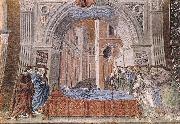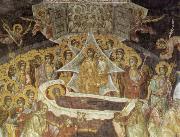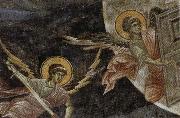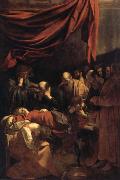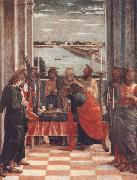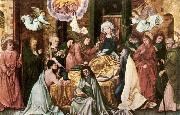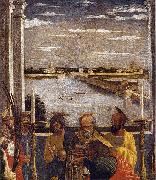Wholesale Oil Painting Reproductions No Minimum and Door to Door! |
|||||||||||
|
|
|||||||||||

|
|||||||||||
|
|
|
||||||||
All Andrea del Castagno Oil Paintings |
||||||||
|
|
||||||||
|
|
||||||||
|
Artist Introduction: Italian
c1421-1457
Andrea del Castagno Location
Italian
c1421-1457
Andrea del Castagno Location
Italian painter. He was the most influential 15th-century Florentine master, after Masaccio, of the realistic rendering of the figure and the representation of the human body as a three-dimensional solid by means of contours. By translating into the terms of painting the statues of the Florentine sculptors Nanni di Banco and Donatello, Castagno set Florentine painting on a course dominated by line (the Florentine tradition of disegno), the effect of relief and the sculptural depiction of the figure that became its distinctive trait throughout the Italian Renaissance, a trend that culminated in the art of Michelangelo. |
||||||||
|
|
||||||||
|
Death of the Virgin Painting ID:: 4747 |
1442-43
Drawing
Basilica di San Marco, Venice |
|||||||
Height Width |
INS/CM Quality |
|||||||
|
X |
| |||||||
|
|
||||||||
All unknow artist Oil Paintings |
||||||||
|
|
||||||||
|
|
||||||||
|
Artist Introduction: |
||||||||
|
|
||||||||
|
|
Death of the Virgin Painting ID:: 30376 |
mk68
Wall painting
Gracanica
Gracanica Parish Church
|
||||||
Height Width |
INS/CM Quality |
|||||||
|
X |
| |||||||
|
|
||||||||
All unknow artist Oil Paintings |
||||||||
|
|
||||||||
|
|
||||||||
|
Artist Introduction: |
||||||||
|
|
||||||||
|
|
Death of the Virgin Painting ID:: 30953 |
mk68
|
||||||
Height Width |
INS/CM Quality |
|||||||
|
X |
| |||||||
|
|
||||||||
All REMBRANDT Harmenszoon van Rijn Oil Paintings |
||||||||
|
|
||||||||
|
|
||||||||
|
Artist Introduction: Born 1606, Died 1669.One of the great Dutch painters and printmakers of the 17th century, Rembrandt van Rijn is best known for his expressive use of light and shadow (also called chiaroscuro) in his many portraits. Raised in Leiden, he studied with Pieter Lastman (1583-1633) in Amsterdam, then returned to Leiden around 1625 and set up shop as a teacher and portrait artist. Sometime between 1630 and 1632 Rembrandt relocated to Amsterdam, where he spent the rest of his career. Though he had his detractors (some of whom considered him coarse and "low born"), Rembrandt was successful and famous during his lifetime, though he fell on financial hard times in his later years. He was a master printer and produced hundreds of group portraits and historical paintings, including The Anatomy Lesson of Dr. Tulp (1632), The Military Company of Captain Frans Banning Cocq (1642) and Aristotle with a Bust of Homer (1653). His portraits -- including a lifelong trail of intriguing and rather frank self-portraits -- reveal his interest in psychological study and continue to be admired as landmarks in Western art. The Military Company of Captain Frans Banning Cocq is also known as "The Night Watch" because it was thought the painting depicted a nighttime scene. When the painting was cleaned in the 1940s it became obvious that it depicted a daytime scene... He married Saskia van Ulenburgh (also Uylenburgh) in 1634. |
||||||||
|
|
||||||||
|
|
Death of the Virgin Painting ID:: 34406 |
mk93
1605-06
Oil on panel
145 1/4x96 1/2in
Louvre
Paris
|
||||||
Height Width |
INS/CM Quality |
|||||||
|
X |
| |||||||
|
|
||||||||
All Andrea Mantegna Oil Paintings |
||||||||
|
|
||||||||
|
|
||||||||
|
Artist Introduction: Italian
1431-1506
Andrea Mantegna Locations
Mantegna was born in Isola di Carturo, close to Padua in the Republic of Venice, second son of a carpenter, Biagio. At the age of eleven he became the apprentice of Francesco Squarcione, Paduan painter. Squarcione, whose original vocation was tailoring, appears to have had a remarkable enthusiasm for ancient art, and a faculty for acting. Like his famous compatriot Petrarca, Squarcione was something of a fanatic for ancient Rome: he travelled in Italy, and perhaps Greece, amassing antique statues, reliefs, vases, etc., forming a collection of such works, then making drawings from them himself, and throwing open his stores for others to study. All the while, he continued undertaking works on commission for which his pupils no less than himself were made available.
San Zeno Altarpiece, (left panel), 1457-60; San Zeno, VeronaAs many as 137 painters and pictorial students passed through Squarcine's school, which had been established towards 1440 and which became famous all over Italy. Padua was attractive for artists coming not only from Veneto but also from Tuscany, such as Paolo Uccello, Filippo Lippi and Donatello. Mantegna's early career was shaped indeed by impressions of Florentine works. At the time, Mantegna was said to be a favorite pupil; Squarcione taught him the Latin language, and instructed him to study fragments of Roman sculpture. The master also preferred forced perspective, the lingering results of which may account for some Mantegna's later innovations. However, at the age of seventeen, Mantegna separated himself from Squarcione. He later claimed that Squarcione had profited from his work without paying the rights.
His first work, now lost, was an altarpiece for the church of Santa Sofia in 1448. The same year Mantegna was called, together with Nicol?? Pizolo, to work with a large group of painters entrusted with the decoration of the Ovetari Chapel in the apse of the church of Eremitani. It is probable, however, that before this time some of the pupils of Squarcione, including Mantegna, had already begun the series of frescoes in the chapel of S. Cristoforo, in the church of Sant'Agostino degli Eremitani, today considered his masterpiece. After a series of coincidences, Mantegna finished most of the work alone, though Ansuino, who collaborated with Mantegna in the Ovetari Chapel, brought his style in the Forl?? school of painting. The now censorious Squarcione carped about the earlier works of this series, illustrating the life of St James; he said the figures were like men of stone, and had better have been colored stone-color at once.
This series was almost entirely lost in the 1944 Allied bombings of Padua. The most dramatic work of the fresco cycle was the work set in the worm's-eye view perspective, St. James Led to His Execution. (For an example of Mantegna's use of a lowered view point, see the image at right of Saints Peter and Paul; though much less dramatic in its perspective that the St. James picture, the San Zeno altarpiece was done shortly after the St. James cycle was finished, and uses many of the same techniques, including the classicizing architectural structure.)
San Luca Altarpiece, 1453; Tempera on panel; Pinacoteca di Brera, MilanThe sketch of the St. Stephen fresco survived and is the earliest known preliminary sketch which still exists to compare to the corresponding fresco. Despite the authentic look of the monument, it is not a copy of any known Roman structure. Mantegna also adopted the wet drapery patterns of the Romans, who derived the form from the Greek invention, for the clothing of his figures, although the tense figures and interactions are derived from Donatello. The drawing shows proof that nude figures were used in the conception of works during the Early Renaissance. In the preliminary sketch, the perspective is less developed and closer to a more average viewpoint however.
Among the other early Mantegna frescoes are the two saints over the entrance porch of the church of Sant'Antonio in Padua, 1452, and an altarpiece of St. Luke and other saints (at left) for the church of S. Giustina, now in the Brera Gallery in Milan (1453). As the young artist progressed in his work, he came under the influence of Jacopo Bellini, father of the celebrated painters Giovanni and Gentile, and of a daughter Nicolosia. In 1453 Jacopo consented to a marriage between Nicolosia to Mantegna in marriage.
|
||||||||
|
|
||||||||
|
|
Death of the Virgin Painting ID:: 40204 |
mk156
c.1461
Oil on panel
54x42cm
|
||||||
Height Width |
INS/CM Quality |
|||||||
|
X |
| |||||||
|
|
||||||||
All HOLBEIN, Hans the Elder Oil Paintings |
||||||||
|
|
||||||||
|
|
||||||||
|
Artist Introduction: (b. 1460/65, Augsburg, d. 1524, Isenheim
was a German painter. He was born in Augsburg, Bavaria and died in Isenheim, Alsace. He and his brother Sigismund Holbein painted religious works in the late Gothic style. Hans the Elder was a pioneer and leader in the transformation of German art from the Gothic to the Renaissance style. He was also a woodcut artist and an illustrator of books, and was a church window designer. |
||||||||
|
|
||||||||
|
|
Death of the Virgin Painting ID:: 63554 |
1490 Tempera on oak panel, 150 x 228,5 cm Museum of Fine Arts, Budapest Signed on the censer: HANS. HOLPAIN. At the turn of the sixteenth century Hans Holbein the Elder, famous painter of altarpieces and portraits, was the leading painter of the rich merchant city of Augsburg. The painting in Budapest is one of his finest works and, indeed, one of the most significant works of German painting at that time. The inscription tells us that it was commissioned by Wolfgang Preu, Canon of Rottenbuch between 1490 and 1500 and that it originally decorated the tomb of the Preu family in the Church of St James at Straubing. The death of the Virgin is placed in a contemporary domestic setting. Mary, represented as a middle-class woman of Augsburg and wearing the clothes of the period, is seen lying on her canopied bed with the Apostles grouped about her like her family - one of them, wearing spectacles, is reading from the Bible. The artist follows the medieval tradition of simultaneous narration by depicting the sequel in the same picture: at the top we see the Virgin's soul, in the form of an innocent young girl in white, ascending to heaven to be received by God the Father. The Virgin Mary is seen surrounded by the apostles assembled, according to the Legenda Aurea, by divine miracle from various remote parts of the world for this solemn occasion. Though they cannot have met for a long time, they do not speak to one another; uncontestably the Virgin remains the centre of the scene. Every activity, every gesture of pain is directed towards her. She is seated in their midst, fragile and graceful, with a dreamy face - of all the faces in the picture hers shows the finest painting - and a halo around her head representing the supernatural element which is, however, hidden by a bonnet, a concession to wordly fashion. The picture is, indeed, marked by a mixture of accentuated verisimilar and supernatural elements. The young apostle-sitting before the bed, absorbed in reading and taking no part in the social gathering - who wears a kind of pince-nez in accordance with the customs of those days, is a veritable genre figure. The books lying on the bed, the censers and aspersorium painted with equally meticulous precision became ubiquitous pieces of the still-lifes of subsequent ages. In this painting Holbein, with exquisite taste and force, blends the traditional, late Gothic approach with a new style of representing nature and reality adopted from Netherlandish painting |
||||||
Height Width |
INS/CM Quality |
|||||||
|
X |
| |||||||
|
|
||||||||
All unknow artist Oil Paintings |
||||||||
|
|
||||||||
|
|
||||||||
|
Artist Introduction: |
||||||||
|
|
||||||||
|
|
Death of the Virgin Painting ID:: 64136 |
1515-25 Oil on wood, 100,4 x 51,7 cm Museum Mayer van den Bergh, Antwerp This unusual Mannerist painting is a masterpiece of Antwerp Mannerism. The artist is referred to as the Master of Amiens. , Artist: UNKNOWN MASTER, Flemish , Death of the Virgin , 1501-1550 , Flemish , painting , religious |
||||||
Height Width |
INS/CM Quality |
|||||||
|
X |
| |||||||
|
|
||||||||
All Andrea Mantegna Oil Paintings |
||||||||
|
|
||||||||
|
|
||||||||
|
Artist Introduction: Italian
1431-1506
Andrea Mantegna Locations
Mantegna was born in Isola di Carturo, close to Padua in the Republic of Venice, second son of a carpenter, Biagio. At the age of eleven he became the apprentice of Francesco Squarcione, Paduan painter. Squarcione, whose original vocation was tailoring, appears to have had a remarkable enthusiasm for ancient art, and a faculty for acting. Like his famous compatriot Petrarca, Squarcione was something of a fanatic for ancient Rome: he travelled in Italy, and perhaps Greece, amassing antique statues, reliefs, vases, etc., forming a collection of such works, then making drawings from them himself, and throwing open his stores for others to study. All the while, he continued undertaking works on commission for which his pupils no less than himself were made available.
San Zeno Altarpiece, (left panel), 1457-60; San Zeno, VeronaAs many as 137 painters and pictorial students passed through Squarcine's school, which had been established towards 1440 and which became famous all over Italy. Padua was attractive for artists coming not only from Veneto but also from Tuscany, such as Paolo Uccello, Filippo Lippi and Donatello. Mantegna's early career was shaped indeed by impressions of Florentine works. At the time, Mantegna was said to be a favorite pupil; Squarcione taught him the Latin language, and instructed him to study fragments of Roman sculpture. The master also preferred forced perspective, the lingering results of which may account for some Mantegna's later innovations. However, at the age of seventeen, Mantegna separated himself from Squarcione. He later claimed that Squarcione had profited from his work without paying the rights.
His first work, now lost, was an altarpiece for the church of Santa Sofia in 1448. The same year Mantegna was called, together with Nicol?? Pizolo, to work with a large group of painters entrusted with the decoration of the Ovetari Chapel in the apse of the church of Eremitani. It is probable, however, that before this time some of the pupils of Squarcione, including Mantegna, had already begun the series of frescoes in the chapel of S. Cristoforo, in the church of Sant'Agostino degli Eremitani, today considered his masterpiece. After a series of coincidences, Mantegna finished most of the work alone, though Ansuino, who collaborated with Mantegna in the Ovetari Chapel, brought his style in the Forl?? school of painting. The now censorious Squarcione carped about the earlier works of this series, illustrating the life of St James; he said the figures were like men of stone, and had better have been colored stone-color at once.
This series was almost entirely lost in the 1944 Allied bombings of Padua. The most dramatic work of the fresco cycle was the work set in the worm's-eye view perspective, St. James Led to His Execution. (For an example of Mantegna's use of a lowered view point, see the image at right of Saints Peter and Paul; though much less dramatic in its perspective that the St. James picture, the San Zeno altarpiece was done shortly after the St. James cycle was finished, and uses many of the same techniques, including the classicizing architectural structure.)
San Luca Altarpiece, 1453; Tempera on panel; Pinacoteca di Brera, MilanThe sketch of the St. Stephen fresco survived and is the earliest known preliminary sketch which still exists to compare to the corresponding fresco. Despite the authentic look of the monument, it is not a copy of any known Roman structure. Mantegna also adopted the wet drapery patterns of the Romans, who derived the form from the Greek invention, for the clothing of his figures, although the tense figures and interactions are derived from Donatello. The drawing shows proof that nude figures were used in the conception of works during the Early Renaissance. In the preliminary sketch, the perspective is less developed and closer to a more average viewpoint however.
Among the other early Mantegna frescoes are the two saints over the entrance porch of the church of Sant'Antonio in Padua, 1452, and an altarpiece of St. Luke and other saints (at left) for the church of S. Giustina, now in the Brera Gallery in Milan (1453). As the young artist progressed in his work, he came under the influence of Jacopo Bellini, father of the celebrated painters Giovanni and Gentile, and of a daughter Nicolosia. In 1453 Jacopo consented to a marriage between Nicolosia to Mantegna in marriage.
|
||||||||
|
|
||||||||
|
|
Death of the Virgin Painting ID:: 84678 |
Date between 1460(1460) and 1464(1464)
Medium Oil on wood
cjr |
||||||
Height Width |
INS/CM Quality |
|||||||
|
X |
| |||||||
|
|
||||||||
All Andrea Mantegna Oil Paintings |
||||||||
|
|
||||||||
|
|
||||||||
|
Artist Introduction: Italian
1431-1506
Andrea Mantegna Locations
Mantegna was born in Isola di Carturo, close to Padua in the Republic of Venice, second son of a carpenter, Biagio. At the age of eleven he became the apprentice of Francesco Squarcione, Paduan painter. Squarcione, whose original vocation was tailoring, appears to have had a remarkable enthusiasm for ancient art, and a faculty for acting. Like his famous compatriot Petrarca, Squarcione was something of a fanatic for ancient Rome: he travelled in Italy, and perhaps Greece, amassing antique statues, reliefs, vases, etc., forming a collection of such works, then making drawings from them himself, and throwing open his stores for others to study. All the while, he continued undertaking works on commission for which his pupils no less than himself were made available.
San Zeno Altarpiece, (left panel), 1457-60; San Zeno, VeronaAs many as 137 painters and pictorial students passed through Squarcine's school, which had been established towards 1440 and which became famous all over Italy. Padua was attractive for artists coming not only from Veneto but also from Tuscany, such as Paolo Uccello, Filippo Lippi and Donatello. Mantegna's early career was shaped indeed by impressions of Florentine works. At the time, Mantegna was said to be a favorite pupil; Squarcione taught him the Latin language, and instructed him to study fragments of Roman sculpture. The master also preferred forced perspective, the lingering results of which may account for some Mantegna's later innovations. However, at the age of seventeen, Mantegna separated himself from Squarcione. He later claimed that Squarcione had profited from his work without paying the rights.
His first work, now lost, was an altarpiece for the church of Santa Sofia in 1448. The same year Mantegna was called, together with Nicol?? Pizolo, to work with a large group of painters entrusted with the decoration of the Ovetari Chapel in the apse of the church of Eremitani. It is probable, however, that before this time some of the pupils of Squarcione, including Mantegna, had already begun the series of frescoes in the chapel of S. Cristoforo, in the church of Sant'Agostino degli Eremitani, today considered his masterpiece. After a series of coincidences, Mantegna finished most of the work alone, though Ansuino, who collaborated with Mantegna in the Ovetari Chapel, brought his style in the Forl?? school of painting. The now censorious Squarcione carped about the earlier works of this series, illustrating the life of St James; he said the figures were like men of stone, and had better have been colored stone-color at once.
This series was almost entirely lost in the 1944 Allied bombings of Padua. The most dramatic work of the fresco cycle was the work set in the worm's-eye view perspective, St. James Led to His Execution. (For an example of Mantegna's use of a lowered view point, see the image at right of Saints Peter and Paul; though much less dramatic in its perspective that the St. James picture, the San Zeno altarpiece was done shortly after the St. James cycle was finished, and uses many of the same techniques, including the classicizing architectural structure.)
San Luca Altarpiece, 1453; Tempera on panel; Pinacoteca di Brera, MilanThe sketch of the St. Stephen fresco survived and is the earliest known preliminary sketch which still exists to compare to the corresponding fresco. Despite the authentic look of the monument, it is not a copy of any known Roman structure. Mantegna also adopted the wet drapery patterns of the Romans, who derived the form from the Greek invention, for the clothing of his figures, although the tense figures and interactions are derived from Donatello. The drawing shows proof that nude figures were used in the conception of works during the Early Renaissance. In the preliminary sketch, the perspective is less developed and closer to a more average viewpoint however.
Among the other early Mantegna frescoes are the two saints over the entrance porch of the church of Sant'Antonio in Padua, 1452, and an altarpiece of St. Luke and other saints (at left) for the church of S. Giustina, now in the Brera Gallery in Milan (1453). As the young artist progressed in his work, he came under the influence of Jacopo Bellini, father of the celebrated painters Giovanni and Gentile, and of a daughter Nicolosia. In 1453 Jacopo consented to a marriage between Nicolosia to Mantegna in marriage.
|
||||||||
|
|
||||||||
|
|
Death of the Virgin Painting ID:: 88578 |
between 1460(1460) and 1464(1464)
Medium Oil on wood
cyf |
||||||
Height Width |
INS/CM Quality |
|||||||
|
X |
| |||||||
|
|
||||||||
|
Prev Next
|
||||||||
|
|
||||||||
|
Related Paintings to Andrea Mantegna :. |
||||||||
|
|
||||||||
|
CONTACT US |
